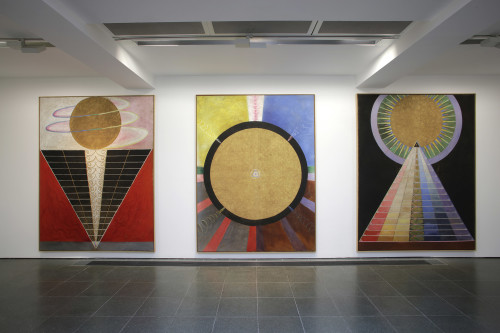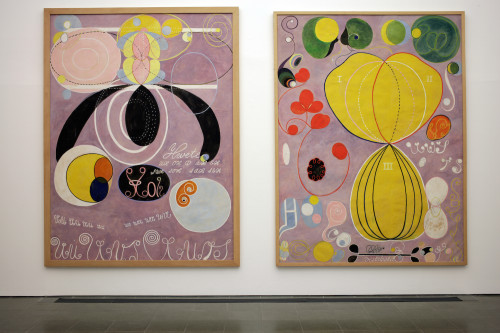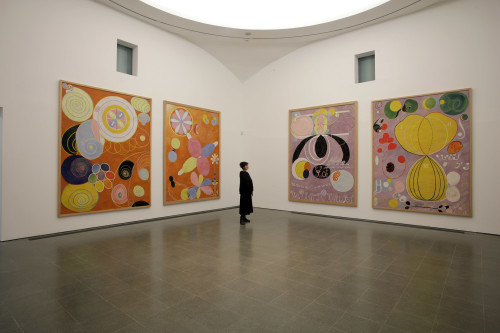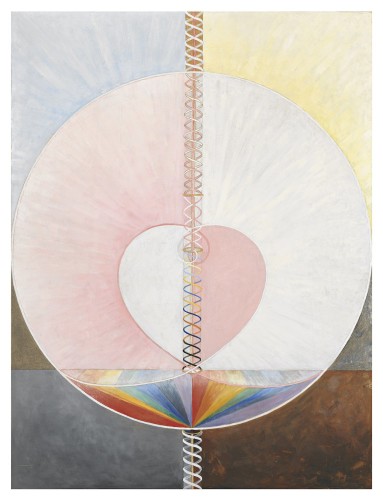LONDON — The Serpentine Gallery is currently exhibiting the work of Swedish artist and mystic Hilma af Klint (1862 -1944). Over her career, af Klint painted nearly 1200 works, at least 200 of which were created during trance rituals and inspired by her esoteric beliefs. Af Klint’s paintings, which have only been exhibited a few times and in limited numbers since the 1980s, are regularly compared to other famous abstract painters of the era, including Wassily Kandinsky, František Kupka, Robert Delaunay, and Piet Mondrian.
Over the past decade, as af Klint’s work has become better known, art historians have been questioning whether it is af Klint, rather than Kandinsky, who is actually the true pioneer of abstract painting.

Hilma af Klint: Painting the Unseen Installation view Serpentine Gallery, London (3 March – 15 May 2016) Image © Jerry Hardman-Jones
As noted in BlouinArtInfo, “[af Klint] painted in near isolation from the European avant-garde, forging her own singular path motivated by her interest in nature, the spiritual realm, and the occult.”
But who was she? Hilma af Klint was born in 1862 to a Protestant family in Sweden and spent her childhood on the family’s farm Hanmora on the island of Adelsö in Lake Mälaren. As the daughter of an admiral in a country that permitted women to study art, af Klint was able to enroll in the Royal Academy of Fine Arts in Stockholm. She began formally studying art at the age of 20.
However, according to various sources, af Klint’s contact with the spiritual world began several years earlier when her sister died in 1880. In addition to dealing with that loss, af Klint encountered the new and increasingly popular spiritual movement: theosophy. At this point in time, the leader of the theosophy movement, Helena Petrova Blavatsky, had traveled the world sharing her philosophy and beliefs. In 1875, Blavatsky established the Theosophical Society, which af Klint joined before or by the time she was enrolled in the Royal Academy. According to several accounts, af Klint’s first seance experience was at the young age of 17.
Over the next few decades, af Klint’s interest in the occult only strengthened and, eventually, it began to influence her painting. As noted by the Serpentine:
From the 1880s, she formed a group with four other female artists called “The Five” (De Fem). Collectively, and in private, they conducted seances leading to experiments with automatic writing and drawing, which anticipated the surrealists by several decades.
In 1905, as af Klint noted in her own writings, she heard “a voice that had given her the following message. ‘You are to proclaim a new philosophy of life and you yourself are to be a part of the new kingdom. Your labours will bear fruit.’ ” This message gave birth to af Klint’s first series of abstract paintings called Primordial Chaos. Prior to that point, af Klint’s work was most representational, featuring landscapes and still-life.

Hilma af Klint: Painting the Unseen; Installation view; Serpentine Gallery, London (3 March – 15 May 2016); Image © Jerry Hardman-Jones
This early abstract series was then followed by hundreds of more abstract works created in trance. The imagery and visuals changed, or evolved as some critics say, as af Klint continued her own spiritual work and artistic journey. For example, the fluid lines, circular patterns and floral compositions of The Ten Biggest were abandoned for harder geometric patterns, large blocks of color and sharp angles. However, what is consistent throughout her abstract work is a genuine seeking to understand and reveal the spiritual through her painting. As noted by the Serpentine:
She felt that the principle of equilibrium and “oneness” was lost at the world’s creation, giving way to a universe of polarities: good and evil, woman and man, matter and spirit, science and religion, macrocosm and microcosm, which she sought to understand and resolve in her paintings.
While af Klint continued to paint throughout her life, none of these abstract works, nor her prolific writings, were ever exhibited or shared publicly in any form. Only her early landscapes and other similar were were ever displayed. Af Klint reportedly felt that the public was not “ready to understand her abstract compositions,” for which she said that she was “only a medium.” She kept the abstract paintings mostly hidden during her lifetime and, in fact, she also stipulated that they should not be publicly displayed until at least 20 years after her death.
But it wasn’t until the 1980s that this actually happened in any “big format” show. In 1986, af Klint’s abstract work was included in an exhibition in Los Angeles called The Spiritual in Art: Abstract Painting 1890-1985. And, although these paintings have been included in shows since, af Klint is still often passed over, remaining relatively unnoticed. As noted in a 2013 New York Times article, she hasn’t “been out there to be seen or traded,” and therefore has not been purchased by large collectors. That makes a difference in notoriety. In addition, as the Times article also notes, af Klint’s work struggles against two other obstacles. Female artists have more trouble gaining recognition in a global art world largely controlled by men and, additionally, there is much “circumspection toward art connected to the mystical and occult.”
However, as mentioned by Julia Voss in her article for The Tate, there is a growing interest in af Klint’s work and, as a result, art history is now being challenged. Wassily Kandinsky, who is largely considered the pioneer or “father” of abstract art, is well-known for his attempts to capture music and sound into color, form and shape. Like af Klint, he also sought a connection between his spiritual life and his expression on canvas. Kandinsky’s first abstract painting, which is reportedly lost, was created in 1911. Af Klint’s first painting, which is on display at the Serpentine, was completed in 1906. Who is the pioneer of this art form?

Hilma af Klint: Painting the Unseen Installation view Serpentine Gallery, London (3 March – 15 May 2016) Image © Jerry Hardman-Jones
The Serpentine’s exhibition, which runs through May, features af Klint’s work from the Paintings for the Temple series (1906 – 1915) and also includes several works completed in the 1920s. Treadwell’s Bookstore owner Christina Oakley Harrington visited the London exhibition and said: “It is awesome. Intellectually engaging throughout, six different rooms, each in a different style as she had various phases.” Oakley Harrington added, “The last few paintings were in a small side niche. I turned the corner, saw them, and was just hit. Instantly my eyes pricked, and I started to weep silently – all in a sudden.”
When asked more specifically about the paintings that “hit her,” Oakley Harrington said it was af Klint’s Dove and Swan series that impacted her the most. She explained, “The captions say that those two sets of paintings explore these birds in Christian and esoteric symbolism. There’s one with four swans who are like the forces of the guardians of the four quarters, and another which encapsulated for me — and hit me with — the feeling of what it is to be in a witches’ circle at points of stillness. This painting (The Dove) is largely abstract but the colour, feel and shapes were full of the power of that experience. I do know she wasn’t a witch but she was in spaces of the night, of candle, of spirit and focus – she was in the presence of invisible forces.”

Serie SUW/UW, Grupp IX/UW, nr 25. Duvan, nr 1, 1915 Olja på duk 151 × 114,5 cm HAK173 © Stiftelsen Hilma af Klints Verk
Hilma af Klint’s art has been published in a number of book formats. One of these publications, Hilma af Klint: The Art of Seeing the Invisible, is a collection of essays based on”many of the lectures given in conjunction with the exhibition” held in Sweden in 2013-2014. The book focuses specifically on the esoteric nature of her art and the influence of the occult on the modernist movement. It also includes entries from af Klint’s own diaries, in which she contemplates her beliefs, her influences, her methods and the imagery in her own paintings.
The 2016 London exhibition Hilma af Klint: Painting the Unseen is co-curated by the Serpentine Galleries in collaboration with Daniel Birnbaum, Director of Moderna Museet, Stockholm. Julia Peyton-Jones, Director, and Hans Ulrich Obrist, Co-Director, Serpentine Galleries, said: “Hilma af Klint is a pioneer of abstract art […] Since her work was last exhibited in the UK, a large body of her paintings has been restored, thanks to the efforts of the Moderna Museet and the Hilma af Klint Foundation. This has allowed never-seen-before works and series to be displayed.” The Serpentine exhibition will be opened through May 15.
The Wild Hunt is not responsible for links to external content.
To join a conversation on this post:
Visit our The Wild Hunt subreddit! Point your favorite browser to https://www.reddit.com/r/The_Wild_Hunt_News/, then click “JOIN”. Make sure to click the bell, too, to be notified of new articles posted to our subreddit.
Thanks for this. Love the Western art of this era, and never heard of this artist. Constructivism on acid?